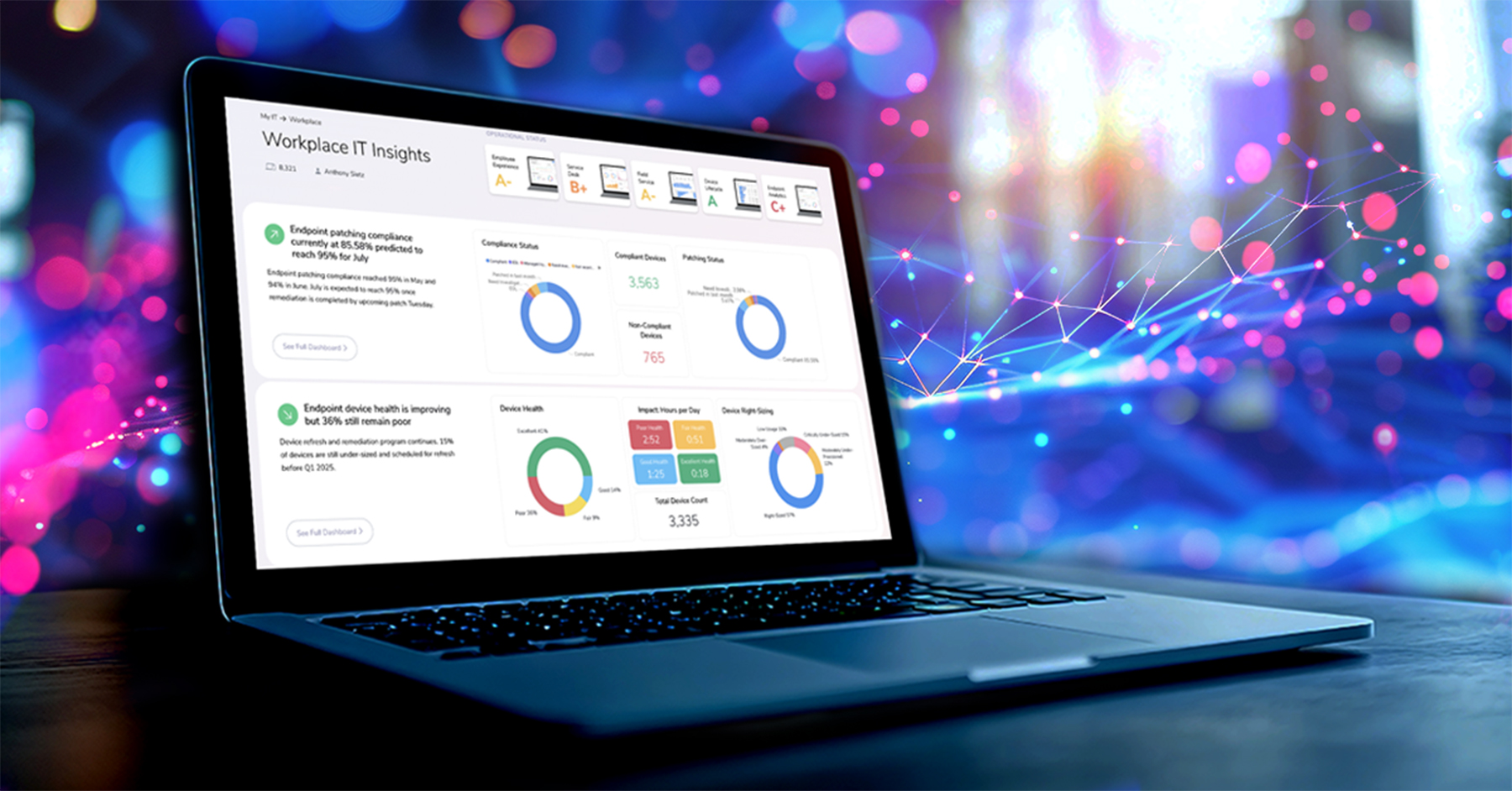- Managed Infrastructure and Cloud Services
- Advanced Technology

Understanding and Optimizing the Remote Work Experience for Your Employees
How Did We Get Here?
A few years ago, having a job that allowed work from anywhere and the chance of a healthy work-life balance did not seem realistic.
Long-term remote work wasn’t even a possibility, as we lacked the right technology to enable an effective distributed workplace; not to mention, most company leaders would have laughed at the idea of allowing a sizable percentage of their employees to work from home, mostly in fear of drastic drops in productivity.
Then, almost overnight, the pandemic required companies to adopt remote work models to maintain business continuity. This sudden change forced them to experiment with new technology and tools, ultimately proving the viability of remote work and that it, in fact, positively affected productivity.
There are several reasons why remote work has become so popular:
- It allows a better work-life balance
- It increases productivity, as employees with autonomy over how and where they work tend to work more efficiently
- It saves employees commuting and other traditional office expenses but also cuts company spending through reduced need for office space
The Challenges
Statistics show many workers prefer remote jobs. A recent Forbes article stated that 87% of respondents thought remote work options improve their work-life balance. And an AT&T study found that the hybrid work model is expected to grow from 42% in 2021 to 81% in 2024.
But it’s not all sunshine and rainbows. Of those not working in the office or at least in a hybrid environment – 30% report they are somewhat disengaged. The reasons behind this include feelings of isolation. Here are just some challenges workers face:
- Effectively communicating and collaborating
- Feeling disconnected from office culture
- Trouble separating work and home life
When asked about distributed work and its challenges, Compucom’s Senior Human Resources Director Krystal Barnes said:
“Remote and hybrid work aren’t going anywhere. Employers need to ensure that their people, processes, and tools can support these models – everything from a seamless onboarding experience to setting and managing clear expectations, so employees are set up for success, all the way through an individual’s last day and their offboarding.“
Krystal Barnes, Compucom Senior Human Resources Director
She went on to say that “one of the biggest areas of opportunity is around communication. It is more important than ever to check in on overall well-being and mental health. How are your peers and your team doing? In the remote world, we’ve lost the “water cooler” talk, so it requires checking in to be more deliberate and planned.”
Four Keys to Remote Work Productivity
To maintain excellent communication, collaboration, and productivity from afar, you need to invest in good-quality IT solutions and services. Enabling employees with great technology experiences and support as they access company data and apps and collaborate with their co-workers will give you a competitive edge over other employers. Four key areas to focus on are:
1. Remote Collaboration Tools
Quality video conferencing, messaging, and project management tools are a must to enable your employees to collaborate and meet critical deadlines.
2. Security Risk Mitigation
Remote work increases security risk; every company has to ensure that employees have secure access to company data and systems.
3. Robust and Secure IT Infrastructure
Optimizing work outside the office may require changes to your infrastructure; companies need to ensure bandwidth, cloud-based storage, and all other resources are in place to support remote workers.
4. A Great Experience
Experience is more than just how an employee feels about and fits into your corporate culture; it’s about getting the job done every day – and no matter where workers are, technology is at the center of the experience.
Working remotely, despite some concerns, will continue as a viable work model; as it evolves, your technology and services need to evolve with it. Addressing these four areas will help you maintain a competitive edge in hiring and retaining your remote workforce.
IT services designed around good employee experiences will help them focus on their jobs without worrying about their devices and technology performance, ultimately giving them the flexibility and work-life balance, they are looking for.
Your company’s IT services are essential to providing an excellent employee and customer experience. An experienced Managed Services Provider (MSP) can not only support your needs but will work with you to understand your environment and tailor their services for you and your employees no matter where they work.
RecenT

Future-Ready IT: Strategies to Optimize, Adapt, and Lead Through Uncertainty

Reimagining IT with the FLO Framework: Inside Compucom’s Geordi Center for Interactive Managed Services and Digital Workplace Solutions

Opportunity in Uncertainty: Optimize Your Remote, Hybrid, or In-Office Setup

9 Ways Strategic IT Staffing Empowers Organizations

Case Studies: Asset Intelligence and Endpoint Compliance Made Easy

AI and the Enterprise: The Future of IT Management
TOPICS
The 4 Keys to Remote Worker Productivity
- Managed Infrastructure and Cloud Services
- Advanced Technology
Understanding and Optimizing the Remote Work Experience for Your Employees
How Did We Get Here?
A few years ago, having a job that allowed work from anywhere and the chance of a healthy work-life balance did not seem realistic.
Long-term remote work wasn’t even a possibility, as we lacked the right technology to enable an effective distributed workplace; not to mention, most company leaders would have laughed at the idea of allowing a sizable percentage of their employees to work from home, mostly in fear of drastic drops in productivity.
Then, almost overnight, the pandemic required companies to adopt remote work models to maintain business continuity. This sudden change forced them to experiment with new technology and tools, ultimately proving the viability of remote work and that it, in fact, positively affected productivity.
There are several reasons why remote work has become so popular:
- It allows a better work-life balance
- It increases productivity, as employees with autonomy over how and where they work tend to work more efficiently
- It saves employees commuting and other traditional office expenses but also cuts company spending through reduced need for office space
The Challenges
Statistics show many workers prefer remote jobs. A recent Forbes article stated that 87% of respondents thought remote work options improve their work-life balance. And an AT&T study found that the hybrid work model is expected to grow from 42% in 2021 to 81% in 2024.
But it’s not all sunshine and rainbows. Of those not working in the office or at least in a hybrid environment – 30% report they are somewhat disengaged. The reasons behind this include feelings of isolation. Here are just some challenges workers face:
- Effectively communicating and collaborating
- Feeling disconnected from office culture
- Trouble separating work and home life
When asked about distributed work and its challenges, Compucom’s Senior Human Resources Director Krystal Barnes said:
“Remote and hybrid work aren’t going anywhere. Employers need to ensure that their people, processes, and tools can support these models – everything from a seamless onboarding experience to setting and managing clear expectations, so employees are set up for success, all the way through an individual’s last day and their offboarding.“
Krystal Barnes, Compucom Senior Human Resources Director
She went on to say that “one of the biggest areas of opportunity is around communication. It is more important than ever to check in on overall well-being and mental health. How are your peers and your team doing? In the remote world, we’ve lost the “water cooler” talk, so it requires checking in to be more deliberate and planned.”
Four Keys to Remote Work Productivity
To maintain excellent communication, collaboration, and productivity from afar, you need to invest in good-quality IT solutions and services. Enabling employees with great technology experiences and support as they access company data and apps and collaborate with their co-workers will give you a competitive edge over other employers. Four key areas to focus on are:
1. Remote Collaboration Tools
Quality video conferencing, messaging, and project management tools are a must to enable your employees to collaborate and meet critical deadlines.
2. Security Risk Mitigation
Remote work increases security risk; every company has to ensure that employees have secure access to company data and systems.
3. Robust and Secure IT Infrastructure
Optimizing work outside the office may require changes to your infrastructure; companies need to ensure bandwidth, cloud-based storage, and all other resources are in place to support remote workers.
4. A Great Experience
Experience is more than just how an employee feels about and fits into your corporate culture; it’s about getting the job done every day – and no matter where workers are, technology is at the center of the experience.
Working remotely, despite some concerns, will continue as a viable work model; as it evolves, your technology and services need to evolve with it. Addressing these four areas will help you maintain a competitive edge in hiring and retaining your remote workforce.
IT services designed around good employee experiences will help them focus on their jobs without worrying about their devices and technology performance, ultimately giving them the flexibility and work-life balance, they are looking for.
Your company’s IT services are essential to providing an excellent employee and customer experience. An experienced Managed Services Provider (MSP) can not only support your needs but will work with you to understand your environment and tailor their services for you and your employees no matter where they work.
Recent Blogs

Future-Ready IT: Strategies to Optimize, Adapt, and Lead Through Uncertainty

Reimagining IT with the FLO Framework: Inside Compucom’s Geordi Center for Interactive Managed Services and Digital Workplace Solutions

Opportunity in Uncertainty: Optimize Your Remote, Hybrid, or In-Office Setup

9 Ways Strategic IT Staffing Empowers Organizations

Case Studies: Asset Intelligence and Endpoint Compliance Made Easy




